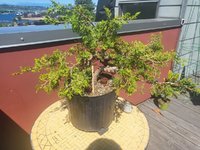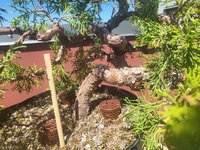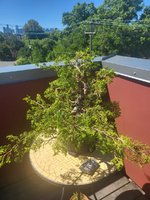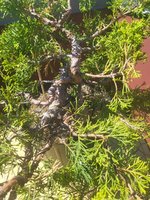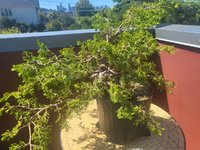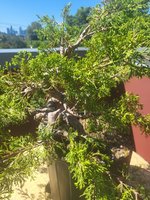pandacular
Masterpiece
I have a shinpaku juniper (Juniperus chinensis) that I purchased as a pre-bonsai (though I'm thinking penjing!) from Robert Cho at Asia Pacific Gardening. This tree has a really interesting trained trunk line, and tons of foliage, some of which has been trained as well. Here are some pictures of the tree the day I got it. The first image shows the preliminary front, the second is 90 degrees counterclockwise.


Currently, the only things I've done to this tree are some cleanup (minor branch selection, taking out tops/bottoms/crotches, and cutting back growing tips) as well as wiring a few branches for photosynthetic efficiency. Here are some pictures of tree after cleanup (taken on a different camera, hence the change in color/luminance):


Over the course of the next year or so, I would like to do the following work on the tree:
1) Repot it into an Anderson flat, or similar container
2) Prune back the longer branches, and boy are the long. Particularly, the branches on the left and back are quite long and need to be managed
3) Wire it up to make all those straight branches match the highly contorted trunk.
My question is regarding timing of these various tasks. The only one I'm certain on is that I must repot in the spring. This is the highest priority of the three, as I don't believe the tree has been repotted in quite some time, and the surface layer is bursting with roots. The substrate, which I believe is pure pumice, is not an issue, but I would like to work the roots and begin preparing it for a bonsai container.
On pruning, I've several different possible times provided, from all year round, to any one of the specific seasons (with the exception of early spring). I understand that this is likely one of the many "it depends" factors, which is why I'm curious for advice on this specific tree, with the scope of work I have planned. I can see arguments both for doing this ASAP, to get some more growth in this season, as well as waiting until dormancy to do it.
Finally, I would also like to wire the tree. I generally see this recommended as a winter or fall activity on junipers, but I would not like to risk the tree being set back during a repot or prune to get some wire on there. It also makes sense to me to do this after pruning, both to make the design clearer and to make it physically easier to work the tree.
I've attached several more pictures of the tree from today, including some close-ups. My ultimate goal is to achieve as much of this work as possible while balancing the health of the tree and avoiding waiting too long to get it all done. I really love this tree and think it has great potential. Thanks in advance for your help!


Currently, the only things I've done to this tree are some cleanup (minor branch selection, taking out tops/bottoms/crotches, and cutting back growing tips) as well as wiring a few branches for photosynthetic efficiency. Here are some pictures of tree after cleanup (taken on a different camera, hence the change in color/luminance):


Over the course of the next year or so, I would like to do the following work on the tree:
1) Repot it into an Anderson flat, or similar container
2) Prune back the longer branches, and boy are the long. Particularly, the branches on the left and back are quite long and need to be managed
3) Wire it up to make all those straight branches match the highly contorted trunk.
My question is regarding timing of these various tasks. The only one I'm certain on is that I must repot in the spring. This is the highest priority of the three, as I don't believe the tree has been repotted in quite some time, and the surface layer is bursting with roots. The substrate, which I believe is pure pumice, is not an issue, but I would like to work the roots and begin preparing it for a bonsai container.
On pruning, I've several different possible times provided, from all year round, to any one of the specific seasons (with the exception of early spring). I understand that this is likely one of the many "it depends" factors, which is why I'm curious for advice on this specific tree, with the scope of work I have planned. I can see arguments both for doing this ASAP, to get some more growth in this season, as well as waiting until dormancy to do it.
Finally, I would also like to wire the tree. I generally see this recommended as a winter or fall activity on junipers, but I would not like to risk the tree being set back during a repot or prune to get some wire on there. It also makes sense to me to do this after pruning, both to make the design clearer and to make it physically easier to work the tree.
I've attached several more pictures of the tree from today, including some close-ups. My ultimate goal is to achieve as much of this work as possible while balancing the health of the tree and avoiding waiting too long to get it all done. I really love this tree and think it has great potential. Thanks in advance for your help!

